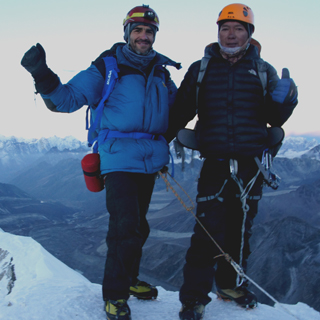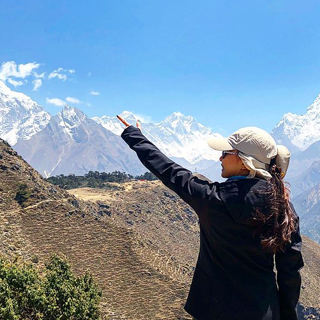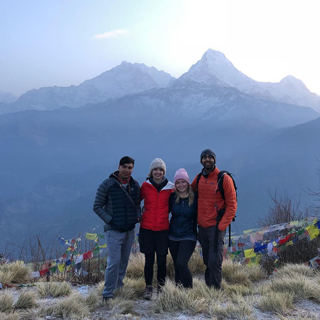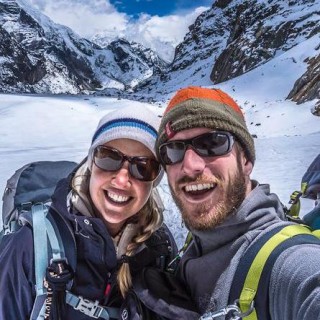Altitude Sickness in Nepal Himalaya
What is altitude sickness?
The higher we go the more our body adapt by breathing faster and deeper. It means the air pressure is low when we are in high altitude. The breath we take the less oxygen so the trekkers suffered from altitude sickness due to not having an extra acclimatization day while on high altitude mountain. Altitude starts to affect us from 2000 meters above.
Altitude sickness common symptoms (Acute Mountain Sickness AMS)
When we are in high altitude our bodies is not adjusted or acclimatize nicely so experience the symptoms of AMS. It is always better descending back 500m to 1000M is recommended until we acclimatize properly before the symptoms are getting worse. Many people throughout the world work at high altitudes. Their bodies have adjusted or acclimatized to the higher altitude over a long period of time. If trekking you may not have as long to acclimatize so it's very important to be aware of some of the symptoms surrounding high altitude trekking.
Acute Mountain Sickness (AMS) common symptoms
- Persistent headache
- Poor appetite
- Nausea (feeling sick) and vomiting
- Fatigue (feeling tired)
- Dizziness
- Poor sleep or sleep disturbance (insomnia)
- Disorientation
- Slight swelling of hands and face
Prevention of AMS
- Acclimatization: After 1000m ascent stay one more night for acclimatization
- Do not make rapid ascent
- No alcohol, no sleeping pills, no smoking, no sex
- Drink more: about 3-4 liters day-clean water (boiled, filtered or medicated), tea, coffee, soup, and juice
- No heavy backpacks
- Climb higher, always sleep lower
- Ascent less than 300m a day above 3.000m of altitude
- Never trek alone
- Eat well and regularly
- Wear proper warm cloth while you are in high altitude.
- Be aware of wind prevention.
- Keep your hands clean as possible during meal and
- If you have mild symptoms, do not proceed higher. Take aspirin tablets.
- If you have worsening symptoms, go down immediately.
- Do not leave your team member behind unattended.
Who should be careful at high altitudes?
- People with heart disease/lung successfully treated.
- Pregnant women
- Children
- People with high blood pressure
- People prone to apnea sleep.
- People who have experienced HAPE or OCHA before.
- Other issues to consider in the mountains are sunburn, temporary blindness caused by snow (ophthalmic) cold, and frost.
Treating Altitude Mountain Sickness
Descent is the best drug or in case of emergency of medical help, please get help of horse to descend down or helicopter rescue,
drink plenty of water and ascend slowly. Medicines can be used to reduce the severity of your symptoms, but it will not completely get rid of them. Tell your travel companions how you feel, even if your symptoms are mild – there's a danger your judgement may not be clear. You can continue going up with care once you feel you have fully recovered.If
If you think you have altitude sickness
- stop and rest where you are
- do not go any higher for at least 24 to 48 hours
- if you have a headache, take ibuprofen or paracetamol
- if you feel sick, take an anti-sickness medicine, such as promethazine
- make sure you're drinking enough water
- do not smoke, drink alcohol, or exercise
- Consider Diamox (125 to 250 mg 12-hourly) for 3 days, or for the rest of the time at altitude if symptoms return
- Consider Stemetil (or other anti-vomiting medication) for continual nausea.
- If AMS symptoms are severe, give oxygen (1 to 2 L/min) OR use a pressure bag until symptoms clear
- Check the victim on a regular basis for signs of HAPE and HACE, especially during the night
- If symptoms of AMS do not improve or get worse, then descend to clear symptoms (at least 500m/1640ft.)
- If you do not feel any better after 24 hours, go down by at least 500m (about 1,600 feet).
- Do not attempt to climb again until your symptoms have completely disappeared.
- After 2 to 3 days, your body should have adjusted to the altitude and your symptoms should disappear.
- See a doctor if your symptoms do not improve or get worse.
Medications to bring while on high altitude trekking
Consider travelling with these medicines for altitude sickness
Following medicaitons are available from most travel clinics. You do not need a prescription to buy it.
- Nifedipine (ordinarily used to treat heart problems and high blood pressure)
- Acetazolamide to prevent and treat high-altitude sickness ( Begin taking acetazolamide 1 to 2 days before you start to go up in altitude and continue to take it while going up)
- Ibuprofen and paracetamol for headaches
- Anti-sickness medicine, such as promethazine, for nausea
- Descomethasone (an important drug to carry for emergency use).
You should still go up gradually and follow the prevention advice, including taking time to acclimatise, having regular rest days and drinking plenty of water. If you get symptoms of altitude sickness while taking above mentioned medicines, rest or go down until you feel better before going up again.
Useful notes
- Do consider a porter for carrying your load if you are carrying to much or feel you are not capable carrying all your belongings comfortably when you are on a trek.
- Make sure that you have proper travel insurance for high altitudes. Make sure that it cover for trekking at an high altitude which can cover your emergency evacuation in case of emergency (should cover helicopter rescue)
- If the symptoms of altitude sickness are ignored, they can lead to life-threatening conditions affecting the brain or lungs.
Remember us for more informaion, Team Leader | Durga KC
-
Clients Review

Excellent Service from Durga - Mount Trails
We had a very impressive ascent of Island Peak, everything works well.Many thanks to Durga, for the organization, including the start and the end of our trip in Kathmandu in the lovely hotel Yala Peak…
Michael Gehrísch, Germany Read More
The memorable trip
This trip is one of the most incredible travel that I ever experience. The host was very genuinely and welcoming throughout the trip. If I have a chance to go back, I would love to…
Koong Chantima, Thailand Read More
Wonderful Experience
We had such a great experience in Nepal, and a lot of that is thanks to Durga. We were there for two months for an internship and wanted to do a trek near the end…
Jillian Raghow, United States Read More
“Best Nepalese Experience You Can Get!”
Recently my wife and I returned from 15 months backpacking around the world, and our most amazing adventure was in the Nepalese Himalayas where we eloped! But this was all possible thanks to Durga and…
Clint B, Australia Read More
Wonderful Trekking
Durga is a wonderful leader. He always thought of our group most relaxing
Jimmy T, Australia Read More
It feel like looking above heaven while trekking.Thank you to sam and our support staff for the best trip in Nepal .- feeling 200%… -
Our Blog
20FebruarySpring is the best time to Trek in Nepal
Spring is a popular time to visit Nepal, as the weather is generally mild and there are many festivals and cultural events taking place. The spring season in Nepal typically lasts from…
Read More20FebruaryBandipur - Authentic village and beautiful hidden gem in Nepal
Bandipur is a small hilltop town located in the Tanahun District of Nepal, approximately 143 km west of the capital city, Kathmandu. It is situated at an elevation of 1,030 meters above…
Read More18MayNepal declares new political map placing Kalapani and Limpiyadhura within its borders
The government has endorsed a new political map that includes Kalapani and Limpiyadhura. The government will soon publicize the new political map that incorporates the territory unilaterally kept by India on its…
Read More11DecemberManaslu Circuit Trek Complete Guide for the better experience
Manaslu circuit trek is one of those trekking trails which reach over 5000 meters altitude. You will be at the height of 5167 meters which is the highest elevation we get…
Read More27AugustGokyo Lake Trek in October
Gokyo Lake Trek in Nepal is the best trekking in Everest Region for any trekker or travelling enthusiast. There are best trekking route in Everest Region, amount them Gokyo Lake Trek is…
Read More



